Amalie Robert Estate Vintage Update: 2018 Bud Break and Breaking News!
Hello and Welcome to Vintage 2018!
This is an Amalie Robert Estate Vintage Update for 2018. A FLOG communication.
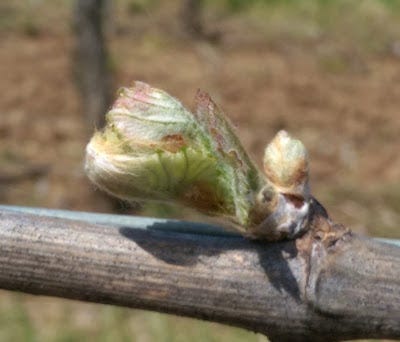
The vines are awake and thanks to a blast of near 90-degree heat in mid-April, they are on the move! And they need to be. They only have about 6 months to ripen aromatically stunning and wonderfully expressive aromas and flavors. No time to waste!
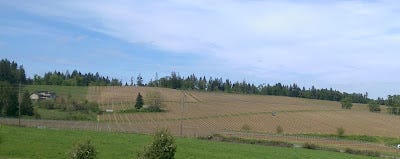
And Ernie was right out there in the middle of it. Can you see him in there? His job this time of year is to change out about 18 acres of vineyard floor – about 20 lineal miles worth - at 2 miles per hour. Out with the old Winter cover crop and in with the brand spanking new Spring cover crop.
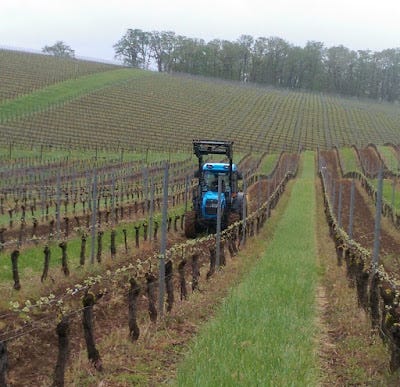
Farmers do it in the rain!
Click the image to see Ernie in action drilling in the Spring cover crop.
The purpose is to provide Springtime nutrition to the vines by incorporating the plants we grew over the winter, so we do not need to add chemical fertilizers to our soil. More on that when we FLOG you with the April Climate Update.

Yes, of course, there are numbers involved. We saw the first buds breaking just before Earth Day in the newest Wadenswil Blocks. We are officially calling April 20th the first day of the 2018 growing season. For everyone who wears tin foil hats and pocket protectors like Ernie, that is Julian Calendar day 110.
Breaking News: Côte Rôtie from Oregon
And speaking of numbers we have some breaking news. It seems that impressive 94-point review for Ernie’s 2012 Top Barrel Syrah has even more meaning than we were aware of.
Having not only the highest score, but the first and only 94-point review for an Estate Grown Willamette Valley Syrah was pretty heartwarming, but there is more to the story. A little spelunking in the Vinous Media database revealed something quite stunning. Maybe the Special Counsel should be looking in there…
Ernie’s cool climate Estate Grown Syrah program is styled after his interpretation of Côte Rôtie. The Syrah grown in that part of the Northern Rhône valley is what really trips his trigger. Guigal and Chapoutier were early influencers that have left an indelible mark on his mind, and maybe some brain damage too. And so Dena let him have an acre to see what he could do.
Well, first things first. He called his friend Dick Erath to come walk the property in 2000 after the cherry trees were pulled and the soil was ready for planting. That was early March and Ernie had Dick up on the hill standing where he wanted to plant his Syrah block. Oddly enough, that exact spot is where Ernie would plant his Chardonnay block and Dick would return in 2013 to conspire with Ernie to make Pabuk’s Gift late harvest Chardonnay. Right, back to the main story.
Dick, standing in 20 miles per hour wind gusts with one hand firmly grasping the hat on his head, was not convinced. “What about down there by your house? See those trees down there are not really being affected by this wind.” Dick shouted. “That area is more protected and will be warmer. You will have a better chance of ripening Syrah down there. Not that you will ripen it, but you will have a better chance.” Dick Erath has made a significant impact on the Oregon Wine industry, and at least at Amalie Robert Estate, continues to do so.
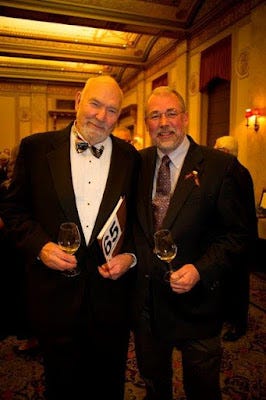
Right, so now we know where Ernie’s little Côte Rôtie from Oregon block is going to be planted, but what to plant? Ah, off to France where he would fortuitously meet Marcel Guigal. And so, there we were, tasting the La Turque from barrel in the Guigal cellars. Ernie looked at Dena and said, “Let’s just make this.”
While it is illegal to take cuttings from France and bring them back to Oregon, knowledge transfer is not so encumbered. Clearly Clone 95 (another Dick Erath contribution to the Oregon Wine Industry) is the exception to the rule. You can read the full story at Rusty Gaffney’s PinotFile site. http://www.princeofpinot.com/article/2033/By the way: our Clone 95 block is bearing fruit this year.
At the end of the day, Ernie left the Guigal facility in Ampuis with a bit of a buzz. Clearly from the wine, but also from the time spent with Marcel Guigal where they talked clones. Northern Rhône clones. Ernie settled on the 4 clones most likely suited to make exceptional Côte Rôtie.

The similarities of Côte Rôtie, in the Northern Rhône valley of France and Dallas, Oregon in the great Pacific Northwest of the United States include the relative proximation to the 45th parallel. While Dallas, Oregon is just below the 45thparallel at 44.9193 degrees, Ampuis, at the heart of Côte Rôtie, is at 45.4890 degrees.
We share a cool climate growing season, but the similarities end there. Our sedimentary Bellpine series soil in the Willamette Valley tends to contribute more floral aromatics and is geologically unrelated to the granite and schist soils found in Côte Rôtie. Yeah, no schist.
Back in Oregon, the hunt was on to find these 4 clones. It turned out two were easily sourced from longtime friend Steve Doerner at Cristom. So, Ernie got two clones in the ground straight away. And two were not so easily sourced. Syrah - Why be difficult, with just a little more effort, you can be impossible?
The next two clones took a couple of years to source. “Don’t give up on your dream” was the encouragement offered by the late Witness Tree winemaker Bryce Bagnall. And so, Ernie persevered, holding open a half acre of land destined for 2 more clones of Syrah.
And when he finally got them, he ended up with a little more than he bargained for. The clonally correct Syrah vines he picked up had a few Viognier vines mixed in. The nursery man told him that they had made a mistake when grafting and some Viognier was in the mix.
Ernie was in shock. He had waited, literally, years for this hair brained scheme to hatch and now this. What to do? Well, he reasoned, they have Viognier interplanted in Côte Rôtie, so maybe this is a good thing. It was certainly looking more and more like Côte Rôtie from Oregon. He collected his plants and drove back to the vineyard.
It took three years, but those vines finally produced the fruit he was so eagerly awaiting. And just like the nursery man had foretold, some of those Syrah vines produced white grapes. Ernie doesn’t call it Viognier, he calls it white Syrah. So, you could say he not only co-ferments with Viognier, he co-grows it as well. He won’t say that, but you could.


Nothing is inherently good or bad, except a snakebite, until it gets a name. Our first bottling of Syrah from the 2006 vintage was without a fanciful name. The 2007 vintage (2007? Really? Yes, 2007. Really.) was featured as “Best Domestic Syrah of the Year” by Wine & Spirits Magazine and answered one of our neighbor’s questions. He said, “Yeah, you should plant Syrah and let us know how it works out for you.”
And that is the reason, beginning with the 2008 vintage, that wine has a fanciful name. We call it Satisfaction, because that is how it worked out for us.

So, what about this Top Barrel bottling? The Top Barrel is that moment in the cellar when you thief out a barrel sample and are immediately taken back to the same experience tasting La Turque from barrel at Guigal. Aromas are powerful things and can trigger very vivid memories. The first one of these moments came with the cool and protracted 2010 vintage.
Ernie said, “No Farmin’ Way am I going to blend this barrel away! We are going to bottle this separately. This is World Class, the Real Deal, Côte Rôtie from Oregon!” And it just so happened that the barrel was on the top row of barrels. So, the name became self-evident – Top Barrel.
After making several tractor passes to incorporate the Winter cover crop, prepare the soil for the Spring cover crop and then finally drill in the Spring cover crop, Ernie had some time on his hands. That and it started to rain, so the tractor work was put on hold.
He queried the Vinous Media database for 2012 wines from the Northern Rhône to see how his top scoring and first ever Estate Grown, Willamette Valley 94-point Top Barrel Syrah would stack up. The neat thing about Vinous Media, is that the same reviewer, Josh Raynolds, covers both Oregon and the Northern Rhône. That removes the key variable in comparing and contrasting wines.
Here is what he found out. The top scoring 2012 vintage wine from Côte Rôtie was a 95-point review, and there were 3 of them. Ok, so that told him that his 94-point review was in the ballpark. And it turns out that Guigal had one of those 95-point reviews. It was La Landonne at a stunning $525 (per bottle) release price.
But he also found out that the other two “La La” bottlings, La Mouline and La Turque, each earned a 94-point review from the same reviewer that rated the Top Barrel with a 94-point review.
Here are the Guigal Côte Rôtie from France reviews along with the Amalie Robert Côte Rôtie from Oregon review:

Guigal La Mouline:
Lurid ruby. Heady, intensely perfumed aromas of red fruit preserves, incense, smoky minerals and lavender, accompanied by an Asian spice flourish that builds as the wine opens up. Stains the palate with sweet, seamless raspberry liqueur, spicecake and floral pastille flavors that are lifted and given spine by core of juicy acidity. Puts on weight and spreads out slowly on the strikingly long and precise finish, which features resonating mineral and floral notes. - 94 points, Josh Raynolds, Vinous Media
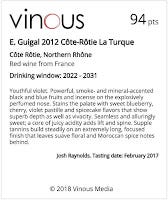
Guigal La Turque:
Youthful violet. Powerful, smoke- and mineral-accented black and blue fruits and incense on the explosively perfumed nose. Stains the palate with sweet blueberry, cherry, violet pastille and spicecake flavors that show superb depth as well as vivacity. Seamless and alluringly sweet; a core of juicy acidity adds lift and spine. Supple tannins build steadily on an extremely long, focused finish that leaves suave floral and Moroccan spice notes behind. - 94 points, Josh Raynolds, Vinous Media
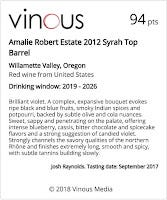
Amalie Robert Top Barrel:
Brilliant violet. A complex, expansive bouquet evokes ripe black and blue fruits, smoky Indian spices and potpourri, backed by subtle olive and cola nuances. Sweet, sappy and penetrating on the palate, offering intense blueberry, cassis, bitter chocolate and spicecake flavors and a strong suggestion of candied violet. Strongly channels the savory qualities of the northern Rhône and finishes extremely long, smooth and spicy, with subtle tannins building slowly. - 94 points, Josh Raynolds, Vinous Media
“Amalie Robert, whose vineyard is in the western part of the Willamette Valley, makes a very strong case for Syrah, but production of their two graceful wines is painfully small, as in just a few barrels of wine per vintage.” - Josh Raynolds, Oregon’s Expanding Palate of Wines, February 2018, Vinous Media
While it is too soon to make any substantive predictions about vintage 2018, we are hopeful that the crews arrive on time, the tractors all start, the sun shines and the rains fall at the appropriate times and in the correct amounts. That would be the vintage of the year!
Kindest Regards,
Dena & Ernie



